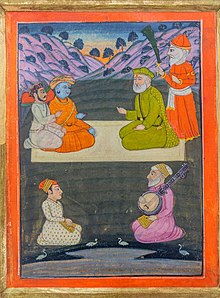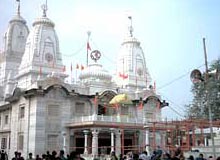Gorakhnath
[14] Gorakhnath led a life as an exponent of ideas of Kumarila and Adi Shankara that championed the Yogic and Advaita Vedanta interpretation of the Upanishads.According to Banerjea, He emphasised that the choice is that of the yogi, and that spiritual discipline and practice by either path leads to "perfectly illumined samadhi state of the individual phenomenal consciousness.According to Bhagawan Nityananda, the samadhi shrine (tomb) of Gorakhnath is at Nath Mandir near the Vajreshwari temple about one kilometre from Ganeshpuri, Maharashtra, India.[23] In his view, the origins of hatha yoga should be associated with the Dashanami Sampradaya of Advaita Vedanta[25] (Hinduism), the mystical figure of Dattatreya,[26] and the Rāmānandīs.[1] According to Arvind-Pal Singh Mandair, a professor in Asian languages and cultures, the Gorakhnath orders were operating free community kitchens in Punjab before Guru Nanak founded Sikhism.[33][34] According to William Northey and John Morris, legend states that a disciple of Machendra by name Gorakhnath once visited Nepal and retired to a small hill near Deo Patan.[35] Dang valley of Nepal, located in the south-west of the country close to India, is regarded as one of the historically significant place for the disciples of Gorakhnath for over 1300 years.[36] As per the legend, the king of Dang named Ratnaparikshak was initiated by Gorakhnath in the valley's forest and later became a famed siddha called Ratnanath, and built a temple.[citation needed] The Siddha Siddhanta Paddhati is a Hatha Yoga Sanskrit text attributed to Gorakhnath by the Nath tradition.[44][45] The Siddha Siddhanta Paddhati text is based on an advaita (nonduality) framework, where the yogi sees "himself in all beings, and all in himself" including the identity of the individual soul (Atman) with the universal (Brahman).[31] This idea appears in the text in various forms, such as the following: The four varna (castes) are perceived to be located in the nature of the individual, i.e. Brahmana in sadacara (righteous conduct), Ksatriya in saurya (valor and courage), Vaisya in vyavasaya (business), and Sudra in seva (service).





meditationlotus positionHatha yogaHinduismNath SampradayaShaivismMatsyendranathmahasiddhaNavnathHagiographiesself-determinationsamadhiGorakhpurBaba FaridJnanesvariGuru NanakSikhismBuddhistAdi ShankaraAdvaita VedantanondualismhagiographyPunjabPeshawarBengalAdinathGaneshaNath traditionLaya yogaBhagawan NityanandaVajreshwari templeMaharashtraGorakhnath MathindologistJames MallinsonDashanami SampradayaDattatreyaRāmānandīslangarPashupatinath Temple, NepalGurkhaGurkhasGorkhaDang valley, NepalDang valleySiddharTamil NaduSiddharsKorakkarAgastyaBhogarNagapattinamVelliangiri MountainsCoimbatoreThiruchendurTrincomaleeSathuragiriKolli HillsmedicinephilosophyalchemycannabisBengali HinduWest BengalTripuraBangladeshRomola ButaliaYogabījaYogacintamaniFeuersteinavadhutaadvaita (nonduality)BrahmanGorakh AyaMaya MachhindraGorakhnath TempleYogi NathGorakh HillRatan Nath TempleTilla JogianList of Hindu gurus and saintsWhite, David GordonBloomsbury PublishingFeuerstein, GeorgYoga JournalGerald James LarsonDictionary of Hindu Lore and LegendInternet ArchiveWayback MachineSubtle bodyThree bodiesFive sheathsChakraSushumnaAsanasDarshana UpanishadPātañjalayogaśāstravivaraṇaGomukhasanaMuktasanaPadmasanaSiddhasanaSimhasanaSopasrayasanaSukhasanaSvastikasanaVirasanaAhirbudhnya SaṃhitāDandasanaKurmasanaAhirbudhnya SamhitaKukkutasanaVimanarcanakalpaMayurasanaAmritasiddhiHemachandra's YogashastraShirshasanaAmaraughaDattatreya Yoga ShastraGoraksha ShatakaVasishtha SamhitaVivekamārtaṇḍaViparita KaraniKhecarīvidyāShiva SamhitaSharngadhara-paddhatiYogatārāvalī